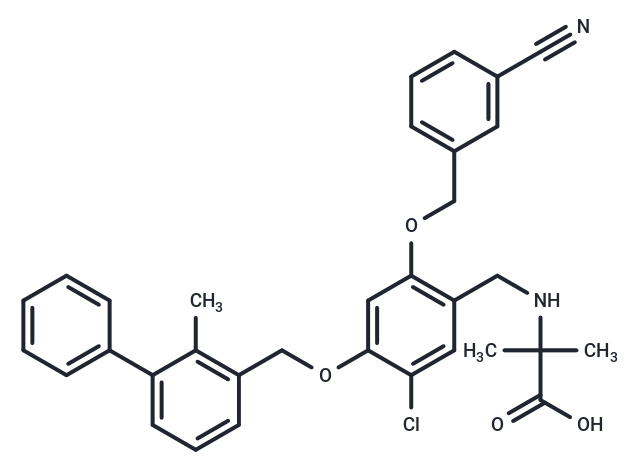Shopping Cart
Remove All Your shopping cart is currently empty
Your shopping cart is currently empty
PD-1/PD-L1-IN-NP19, a PD-1/PD-L1 inhibitor, exhibits an IC50 of 12.5 nM against the human PD-1/PD-L1 interaction, potentially activating the tumor immune microenvironment and contributing to its antitumor effects[1].

| Pack Size | Price | USA Warehouse | Global Warehouse | Quantity |
|---|---|---|---|---|
| 5 mg | $376 | - | In Stock | |
| 25 mg | $1,140 | - | In Stock | |
| 50 mg | $1,490 | - | In Stock | |
| 100 mg | $2,360 | - | In Stock |
| Description | PD-1/PD-L1-IN-NP19, a PD-1/PD-L1 inhibitor, exhibits an IC50 of 12.5 nM against the human PD-1/PD-L1 interaction, potentially activating the tumor immune microenvironment and contributing to its antitumor effects[1]. |
| Targets&IC50 | PD-1/PD-L1 (human):12.5 nM (IC50) |
| In vitro | PD-1/PD-L1-IN-NP19 (compound NP19) (0.37-10 μM; 72 h) significantly elevates IFN-γ production in a dose-dependent manner from T cells co-cultured with tumor cells[1]. PD-1/PD-L1-IN-NP19 exhibits much lower activity for inhibiting mouse PD-1/PD-L1 interaction (IC50 >1 μM) compared to human PD-1/PD-L1 interaction (IC50=12.5 nM)[1]. PD-1/PD-L1-IN-NP19 (10 μM; 48 h) shows no apparent cytotoxic effects on A549, MCF-7, and B16-F10 cells at a concentration of 10 μM[1]. |
| In vivo | PD-1/PD-L1-IN-NP19 (compound NP19) (25-100 mg/kg; intragastric gavage once daily for 15 days) significantly inhibits melanoma tumor growth in mice. Additionally, PD-1/PD-L1-IN-NP19 (25 mg/kg; i.p. daily for 14 days) exhibits substantial antitumor efficacy with a tumor growth inhibition (TGI) of 76.5% and is well-tolerated in an H22 hepatoma mouse model. In rats, PD-1/PD-L1-IN-NP19 (1 mg/kg; i.v.) has a half-life (t1/2) of 1.5±0.5 hours, clearance rate (CL) of 0.9±0.2 L/h/kg, and an apparent distribution volume (Vss) of 2.1±0.5 L/kg. Furthermore, when administered orally at 10 mg/kg, PD-1/PD-L1-IN-NP19 shows an absorption time (Tmax) of 0.6±0.2 hours, a long half-life (t1/2) of 10.9±7.7 hours, and an oral bioavailability (F) of 5% in rats. |
| Synonyms | PD-1/PD-L1-IN-NP19 |
| Molecular Weight | 555.06 |
| Formula | C33H31ClN2O4 |
| Cas No. | 2377916-66-8 |
| Smiles | Cc1c(COc2cc(OCc3cccc(c3)C#N)c(CNC(C)(C)C(O)=O)cc2Cl)cccc1-c1ccccc1 |
| Color | White |
| Appearance | Solid |
| Storage | store at low temperature | Powder: -20°C for 3 years | In solvent: -80°C for 1 year | Shipping with blue ice/Shipping at ambient temperature. | ||||||||||
| Solubility Information | DMSO: 1.8 mg/mL (3.24 mM), Sonication is recommended. | ||||||||||
Solution Preparation Table | |||||||||||
DMSO
| |||||||||||
| Size | Quantity | Unit Price | Amount | Operation |
|---|

Copyright © 2015-2026 TargetMol Chemicals Inc. All Rights Reserved.